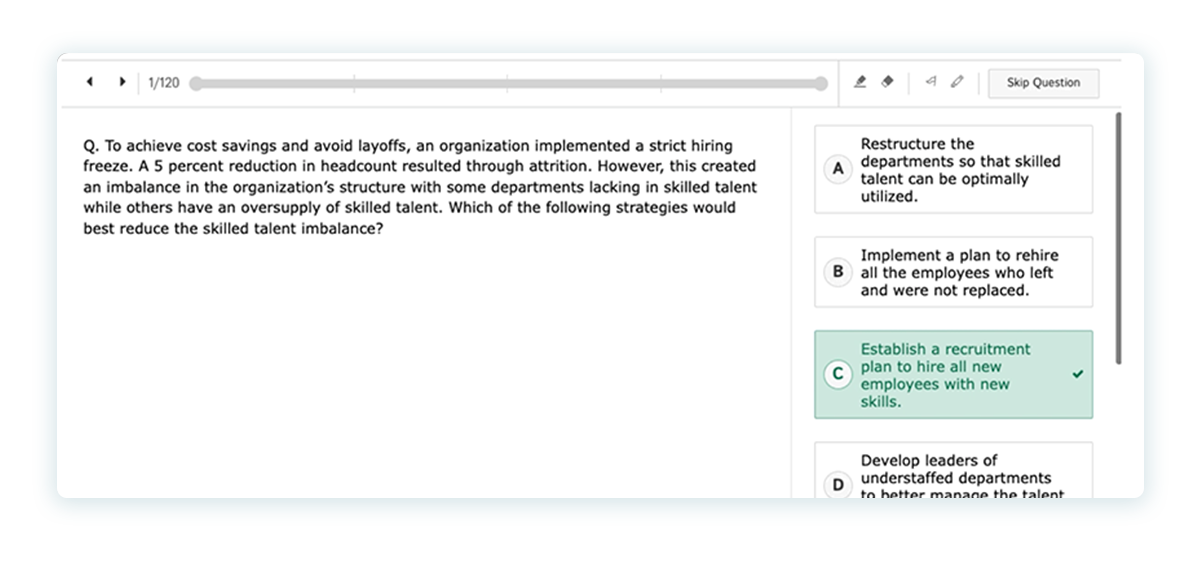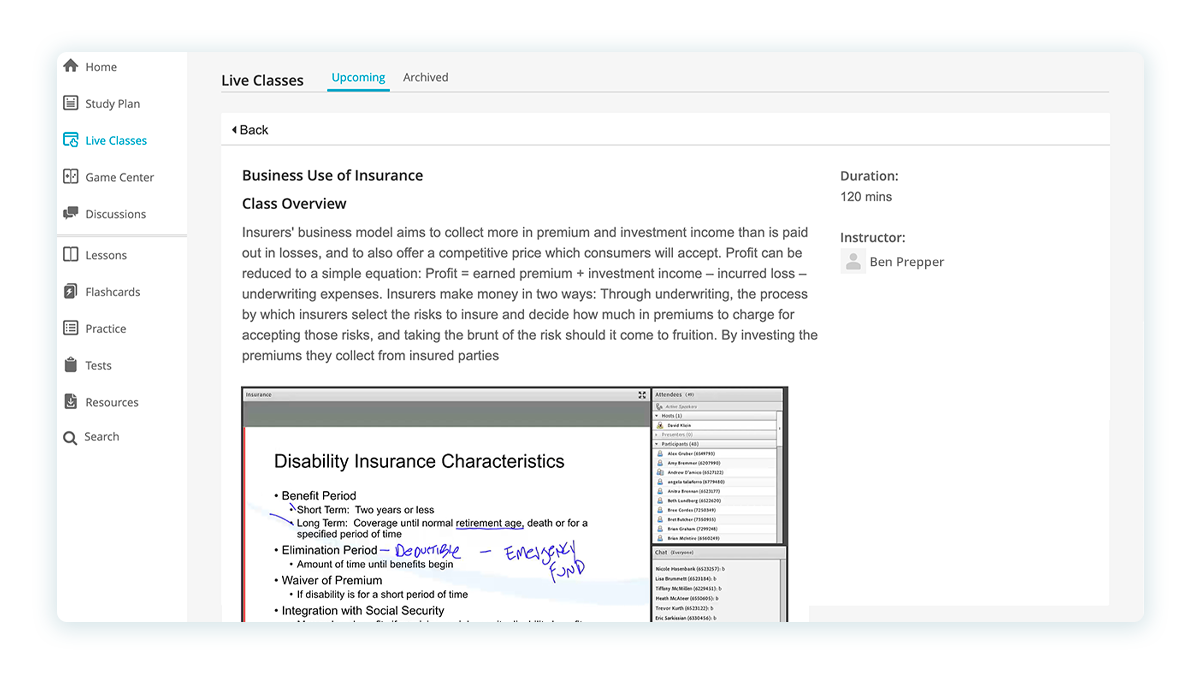5 Tips To Repurpose Instructor-Led Content for Creating a Digital Test Prep Course [That Candidates Actually Want To Buy]
Learn how to strategically repurpose instructor-led course content to create a lucrative digital test prep course learners will thrive in.
You already have effective, instructor-led training (ILT) courses that you’re proud of. But what happens when you need to transfer those courses to an online learning space?
While pivoting toward eLearning exposes you to a broader audience, it isn’t as simple as just copying and pasting your ILT course onto a slideshow presentation. Developing an effective digital test prep course goes much, much deeper.
Thankfully, you won’t have to toss everything out the window and start from scratch. But to successfully convert your ILT to a digital format, you must develop a strategic approach, prepare ahead of time, and execute your plan effectively.
When it comes to preparing for a high-stakes exam, the data speaks for itself: 81% percent of college students feel eLearning improves their grades—but this hinges on an eLearning course that’s actually effective.
In this blog, you will learn actionable steps you can take to convert your instructor-led test prep course content into a lucrative digital test prep course.
1. Determine Your eLearning Course Objectives and Analyze Your Existing In-Person Content
Converting your ILT courses into a digital format is more than just a simple upload.
It’s best to first determine your course objectives for the online program. What information do you need to convey? Does your current content do an effective job at conveying this message? Could there be a better way of organizing your content so that it will better engage your learners?
A digital test prep course needs a solid foundation to ensure learners get the most out of the program. Furthermore, your eLearning objectives must align with your business goals.
Next, take a fine-toothed comb to your ILT programs to identify the most valuable content. Chop any fluff or filler content that is unnecessary material. You can always add some of the fluffy content back in later, but getting to the bare bones of the course content first is important to ensure all the necessities are covered.
Blended learning is a valuable approach, but doing it right is the key to high-value learning. Take the following steps to analyze your current ILT content:
Organize Your Material
Before moving into a digital space, you should organize your ILT material. This helps identify helpful content while weeding out any filler content. You can break your course material down by category, type, and structure in this step.
Check For Accuracy
Make sure the ILT content you’re converging lines up with current best practices. If you’re converting lessons that are several years old, keep an eye out for inaccurate or outdated information.
Identify Areas For Interactivity
Interactivity is an essential feature of any digital test prep course. It keeps learners engaged and improves course mastery. Determine which lessons in your ILT program are best suited for interactivity.
2. Optimize Online Course Content For Your Candidates
Now that you’ve identified your learning objectives and most beneficial content, it’s time to convert. Keep in mind that your learners are the most valuable asset you have. Understanding your learners is crucial to developing the best digital test prep course for them.
It all comes down to format: how will you convey the information based on the target audience? For example, a team of busy professionals preparing for certification exams benefits more from bite-sized content they can review for learning on the go.
Perhaps your company specializes in ACT, SAT, and AP test prep. In this case, your learners are mostly college-bound high school students. They may benefit more from a series of practice multiple choice and passage-based questions.
Or if your company sells a digital test prep course for IT certification, your audience of IT professionals will likely get the most out of video tutorials, hands-on interactions, and screencasts.
Let’s imagine the stakes are much higher, and you’re selling courses to help pre-med or pre-law students prepare for medical and law school. Your digital test prep course must go beyond basic multiple-choice assessments, incorporating more thought-provoking side-by-side questions. This is also true for real estate license training, as laws and regulations vary from state to state.

3. Repurpose Existing Training Content as Practice Opportunities
There’s no need to scrap your existing instructor-led material. Instead, you can easily repurpose the material into practice tests and quizzes to bolster your digital test prep course. After all, the point of practice assessments is to cover the material learned in training. Repurposing that material is a great way to reinforce knowledge for the learner.
A prep course replete with practice opportunities allows candidates to learn at their own pace. It’s crucial that digital test prep course providers get their practice assessments up and running to strengthen their online offerings; thankfully, they should have plenty of material from the ILT courses. They can even blend the two by adding self-paced learning initiatives, like practice tests and quizzes, to the ILT program.
In the end, practice opportunities provide learners with valuable feedback. You’ll also get useful performance data from your digital test prep course.
4. Unbundle Your Instructor-Led Content Into Microlearning Opportunities Online
You might have the best digital test prep course on the market, but none of that matters if you can’t sell it. As with any product or service, you must ensure your marketing efforts are as strong as the course itself. It all begins with your target audience. Who is this digital learning course for? What are the best marketing decisions you can make to target that audience?
Many online courses come with bundle deals like eBooks, interactive courses, practice assessments, and exam vouchers. They’re a fantastic means to market and sell the full package.
However, decoupling those bundles into bite-size microlearning lessons is a great way to attract new and loyal learners. Now, they can purchase short-form test prep options, such as practice questions.
Professionals rely on reviews and testimonials to determine if an online course is right for them. They want to hear it from people who took the class and whether or not it helped them come exam time. You can drive individual and full-packed sales by tying these reviews to each unbundled asset.
5. Employ Virtual Instructor-Led Training Best Practices to Boost Candidate Loyalty
Your test prep courses are only as good as your training content and instructors, whether in-person or digitally. Therefore, you must employ some best practices to ensure your materials deliver high-quality training lessons to your virtual learners. Let’s look at some of these best practices for virtual ILT (VILT), and how they can vastly improve your digital test prep course.
Defeating Distraction
Virtual learners don’t feel the same social pressure to pay attention to online instructors that in-person courses cultivate. The average user only spends 15 seconds on a webpage, so your goal is to grab and hold their attention quickly.
Combat distraction by launching activities to engage learners as soon as they log in. This could be a fun quiz, a game, or a reflective question. By engaging from the get-go, you’re giving users a reason not to switch tabs, check their email, or look at their phones.
Set the Rules
Before beginning the course, virtual instructors should establish classroom rules.
- Do participants have to keep their cameras on?
- Can they interject with questions, or should they wait until the end?
- Should they all mute themselves and put their phones away to avoid distraction?
No matter the audience, rules help cement the virtual instructor as the authority figure in the digital classroom. Keep Learners Engaged
Keep Learners Engaged
 Keep Learners Engaged
Keep Learners EngagedThe easiest way to lose learners’ attention and loyalty is with boring and disengaging content. Mix up your virtual training sessions with interactive lessons to drive engagement. This includes multimedia elements like audio and video clips, animations, games, infographics, and polls.
You can also take steps to get learners to interact with each other. Create a collaborative environment, where the virtual instructor asks open-ended questions that encourage conversation in the digital classroom. Building community is a key strategy for learner engagement.
Convert Your ILT Courses With BenchPrep
Integrate your ILT content into a new exciting eLearning format.
By identifying the most beneficial lessons within your ILT program and determining your target audience, you can easily repurpose the information to create valuable self-learning opportunities.

![5 Tips To Repurpose Instructor-Led Content for Creating a Digital Test Prep Course [That Candidates Actually Want To Buy]](https://blog.benchprep.com/hubfs/Blog/Blog%20Posts%20Featured%20Images/5_Tips_To_Repurpose_Instructor-Led_Content_To_Create_a_Digital_Test_Prep_Course_header.png)




